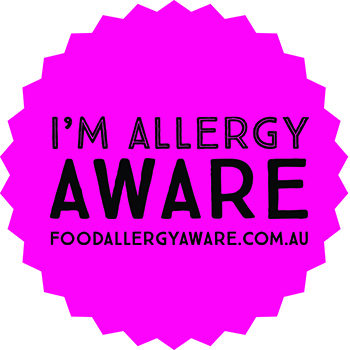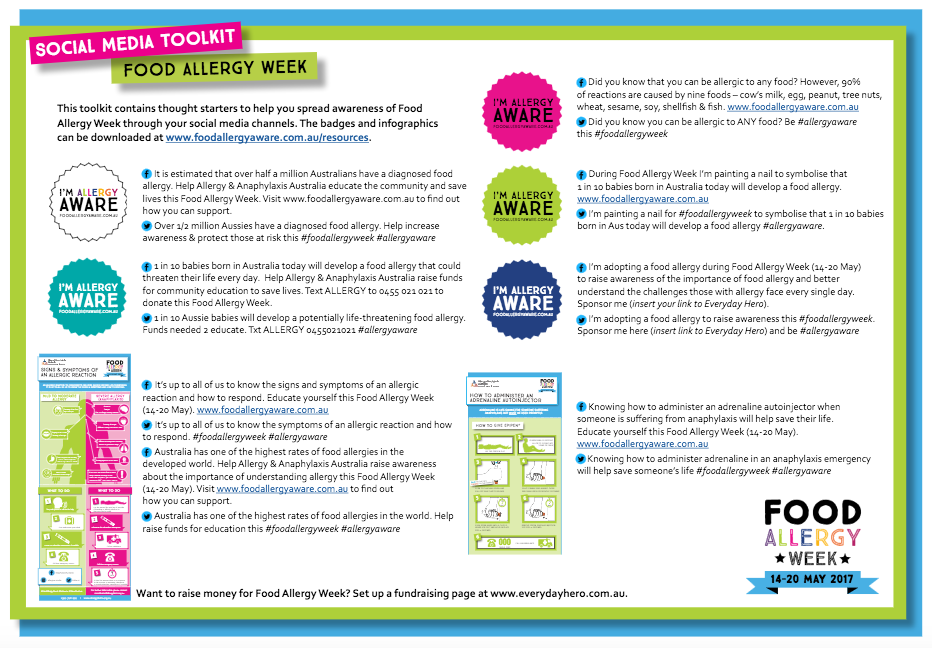 This week is Food Allergy Awareness Week in Australia, and we think it’s a great time to talk about the importance of the proper diagnosis and treatment of food allergy. You’ll find heaps of helpful information and ways you can support food allergy awareness at the campaign site foodallergyaware.com.au – you can paint a nail to show your support, raise awareness at your school or workplace, or adopt an allergy for a day to raise awareness and show you care.
This week is Food Allergy Awareness Week in Australia, and we think it’s a great time to talk about the importance of the proper diagnosis and treatment of food allergy. You’ll find heaps of helpful information and ways you can support food allergy awareness at the campaign site foodallergyaware.com.au – you can paint a nail to show your support, raise awareness at your school or workplace, or adopt an allergy for a day to raise awareness and show you care.
It is estimated that 1 in 10 children have food allergies, and although most will outgrow them, approximately 2% of Australian adults have food allergies that persist throughout their life.
According to the experts at ASCIA (the Australian Society of Clinical Immunology and Allergy) 90% of food allergic reactions are caused by 9 foods. These common culprits include cow’s milk, egg, peanut, tree nuts, sesame, soy, fish, shellfish and wheat.
But what actually is food allergy?
Food allergy is an immune system response to a food protein that the body mistakenly believes is harmful. When the individual eats food containing that protein, the immune system releases massive amounts of chemicals, triggering symptoms that can affect a person’s breathing, gastrointestinal tract, skin and/or heart.
Signs and symptoms of food allergy can be mild, moderate or severe. An allergic reaction can include; hives, swelling of the lips, face and eyes, abdominal pain, vomiting, swelling of the tongue, swelling of the throat, breathing difficulty, persistent dizziness and/collapse. If left untreated, signs and symptoms related to breathing and heart/blood pressure can be fatal.

How do we know if someone has food allergies? How are they diagnosed?
Typically, true food allergies are easy to recognize. The symptoms commonly occur within minutes to hours of eating the food, and happen each time the food is consumed (the reaction sometimes increasing with each exposure).
But according to ASCIA, sometimes food allergy may be less obvious. Symptoms of food allergy that are less common include reflux of stomach contents, eczema, chronic diarrhoea, colic and failure to thrive in babies.
If you suspect you or your child has had an allergic reaction to a food, see your doctor.
They will normally ask a series of questions, to narrow down the list of likely causes (foods, medicines, stinging insects, environmental allergens) and refer you on for specialist advice. Skin prick allergy tests and allergy blood tests are often ordered, which can help to confirm or exclude potential triggers.
Importantly, skin prick tests (SPT) and allergy blood tests do not provide a diagnosis in themselves. False positives are possible – meaning that the immune system produces a response to the food, yet the food doesn’t cause symptoms in that person. And sometimes, although the person reacts severely to a food, SPT and blood tests may be negative.
This is why such tests need to be interpreted by an experienced specialist, who will look at the results, as well as the clinical history of reactions, before recommending a plan of action. Sometimes a temporary elimination diet, followed by food challenges (under close supervision of doctors and dietitians) may be needed to confirm the significance of positive test results.

Is it allergy, or intolerance, or something else?
Not all adverse reactions to foods are due to allergy. In fact, food intolerance is far more common, and can cause a variety of symptoms. Food intolerance reactions can cause:
- headaches
- behavioural changes
- gastrointestinal symptoms
- skin reactions
The important difference with food intolerance is that it does not involve the immune system and does not cause severe allergic reactions (known as anaphylaxis).
In fact, food intolerance can be very difficult to pin down, as reactions tend to be inconsistent, and are affected not only by the dose and frequency of the food eaten, but also the individual’s threshold on that given day. Intolerance reactions can happen due to various components found in food, including natural and added sugars, food chemicals, additives and proteins. This means that rarely is the intolerance to one food – more likely you will react to a number of foods which contain the problem component.
One of the simplest examples of food intolerance is lactose intolerance: In many individuals, the enzyme lactase – which helps us digest the lactose sugar – is deficient. But rather than avoiding all dairy products, simply choosing some lactose free products (milk, yoghurt, ice cream), and including regular cheese, cream and butter is well tolerated.
The sum up:
This week is Food Allergy Awareness Week! Head on over to foodallergyaware.com.au for more information on food allergy and anaphylaxis, and learn how we can make the world a safer place for those with food allergy.
If you believe you have food allergy or intolerance symptoms, head to your doctor, and discuss your symptoms. Seek out specialist referrals to medical professionals and dietitians with experience in this area.
Got more questions? Come and see us at Shepherd Works, for an individual dietary consultation.




